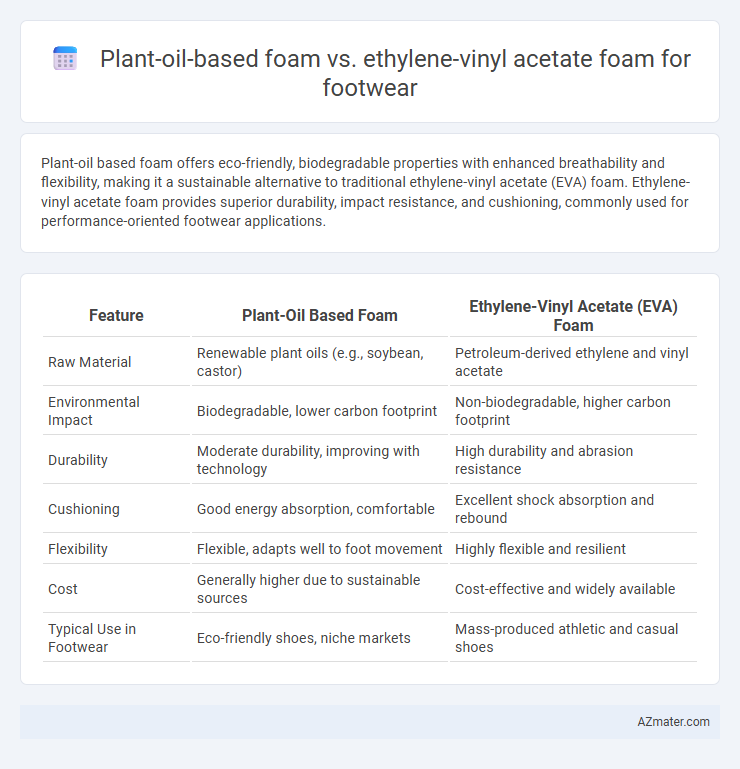Plant-oil based foam offers eco-friendly, biodegradable properties with enhanced breathability and flexibility, making it a sustainable alternative to traditional ethylene-vinyl acetate (EVA) foam. Ethylene-vinyl acetate foam provides superior durability, impact resistance, and cushioning, commonly used for performance-oriented footwear applications.
Table of Comparison
| Feature | Plant-Oil Based Foam | Ethylene-Vinyl Acetate (EVA) Foam |
|---|---|---|
| Raw Material | Renewable plant oils (e.g., soybean, castor) | Petroleum-derived ethylene and vinyl acetate |
| Environmental Impact | Biodegradable, lower carbon footprint | Non-biodegradable, higher carbon footprint |
| Durability | Moderate durability, improving with technology | High durability and abrasion resistance |
| Cushioning | Good energy absorption, comfortable | Excellent shock absorption and rebound |
| Flexibility | Flexible, adapts well to foot movement | Highly flexible and resilient |
| Cost | Generally higher due to sustainable sources | Cost-effective and widely available |
| Typical Use in Footwear | Eco-friendly shoes, niche markets | Mass-produced athletic and casual shoes |
Introduction to Sustainable Footwear Materials
Plant-oil based foam, derived from renewable resources such as soybean or castor oil, offers a biodegradable and lower-carbon-footprint alternative to traditional ethylene-vinyl acetate (EVA) foam widely used in footwear. EVA foam, synthesized from petroleum-based ethylene and vinyl acetate monomers, provides lightweight cushioning and durability but poses environmental challenges due to its non-biodegradable nature and reliance on fossil fuels. Shifting to plant-oil based foams enhances sustainability in footwear by reducing dependence on petrochemicals and promoting material circularity through bio-based and potentially compostable components.
Overview of Plant-Oil Based Foams
Plant-oil based foams for footwear are derived from renewable resources such as soybean, castor, or palm oil, offering enhanced biodegradability and reduced environmental impact compared to traditional ethylene-vinyl acetate (EVA) foams. These bio-based foams exhibit comparable cushioning, flexibility, and durability, making them suitable for midsoles and insoles in athletic and casual shoes. Innovations in plant-oil foam formulations also provide improved moisture management and lower carbon footprints, appealing to eco-conscious consumers and brands prioritizing sustainability.
Ethylene-Vinyl Acetate (EVA) Foam: A Footwear Standard
Ethylene-vinyl acetate (EVA) foam stands as a footwear industry standard due to its exceptional softness, flexibility, and shock absorption properties that enhance comfort and performance. EVA foam's lightweight and durable nature supports long-lasting wear, making it widely used in midsoles, outsoles, and insoles across athletic and casual shoe designs. Compared to plant-oil based foams, EVA offers superior water resistance and stability under diverse environmental conditions, ensuring consistent cushioning and foot protection.
Material Composition: Plant-Oil Foams vs EVA Foams
Plant-oil based foams are derived primarily from renewable resources such as soybean or castor oils, offering enhanced biodegradability and lower environmental impact compared to traditional ethylene-vinyl acetate (EVA) foams, which are petrochemical-based polymers composed of ethylene and vinyl acetate monomers. The molecular structure of plant-oil foams allows for increased flexibility and cushioning through bio-polyol integration, whereas EVA foams provide consistent durability and elasticity due to their copolymer composition. Material scientists emphasize the sustainable advantages of plant-oil based foams in reducing carbon footprint while maintaining comparable performance characteristics essential for footwear midsoles and insoles.
Environmental Impact and Sustainability
Plant-oil based foam, derived from renewable resources such as soybean or castor oil, significantly reduces carbon footprint and reliance on fossil fuels compared to ethylene-vinyl acetate (EVA) foam, which is petroleum-based. The biodegradable properties of plant-oil foams enhance end-of-life sustainability, whereas EVA foams contribute to microplastic pollution and landfill accumulation. Lifecycle analyses reveal that plant-oil foams offer lower greenhouse gas emissions and improved recyclability, aligning with the footwear industry's eco-friendly and circular economy goals.
Performance and Durability Comparison
Plant-oil based foams exhibit superior environmental sustainability and enhanced cushioning resilience compared to ethylene-vinyl acetate (EVA) foams, maintaining flexibility under varying temperatures and resisting compression set over extended use. EVA foam offers excellent shock absorption and lightweight characteristics but tends to degrade faster under UV exposure and mechanical stress, leading to reduced durability in high-wear footwear applications. Performance tests indicate plant-oil based foams retain structural integrity and elasticity longer, making them a preferred choice for durable, eco-friendly footwear midsoles.
Comfort and Cushioning Properties
Plant-oil based foam demonstrates superior breathability and natural moisture-wicking properties that enhance overall foot comfort compared to ethylene-vinyl acetate (EVA) foam. The cushioning in plant-oil foams offers better energy return and reduced compression set, contributing to prolonged shock absorption and fatigue reduction. In contrast, EVA foam, while lightweight and durable, tends to retain heat and may compress over time, potentially diminishing cushioning effectiveness in footwear applications.
Cost-Effectiveness and Market Availability
Plant-oil based foam offers a cost-effective alternative to ethylene-vinyl acetate (EVA) foam in footwear production due to its renewable raw materials, potentially lowering long-term expenses as oil prices fluctuate. Market availability of plant-oil foams is expanding as demand for sustainable and eco-friendly footwear grows, although EVA foam remains widely available and dominant in the market due to established production infrastructure. Manufacturers seeking balance between sustainability and cost often weigh plant-oil foam's increasing accessibility against EVA foam's proven performance and extensive supply chains.
Consumer Preferences and Industry Trends
Plant-oil based foam in footwear is favored for its sustainable, biodegradable properties and lower carbon footprint, aligning with growing consumer demand for eco-friendly products. Ethylene-vinyl acetate (EVA) foam maintains popularity due to its lightweight, durable cushioning and cost-effectiveness, essential for athletic and casual shoes. Industry trends reveal a shift toward hybrid foams combining plant-based materials with EVA to balance environmental impact and performance, reflecting evolving consumer preferences for sustainable yet high-functionality footwear.
Future Prospects in Footwear Foam Innovation
Plant-oil based foam offers a sustainable alternative to ethylene-vinyl acetate (EVA) foam by reducing reliance on petrochemicals and lowering carbon footprints in footwear manufacturing. Advances in bio-based polymers and improved mechanical properties of plant-oil foams suggest potential for wider adoption in high-performance athletic and casual footwear. Innovations in blend formulations and recycling technologies are expected to enhance durability, comfort, and environmental impact, positioning plant-oil foams as a leading material in future footwear foam innovation.

Infographic: Plant-oil based foam vs Ethylene-vinyl acetate foam for Footwear
 azmater.com
azmater.com